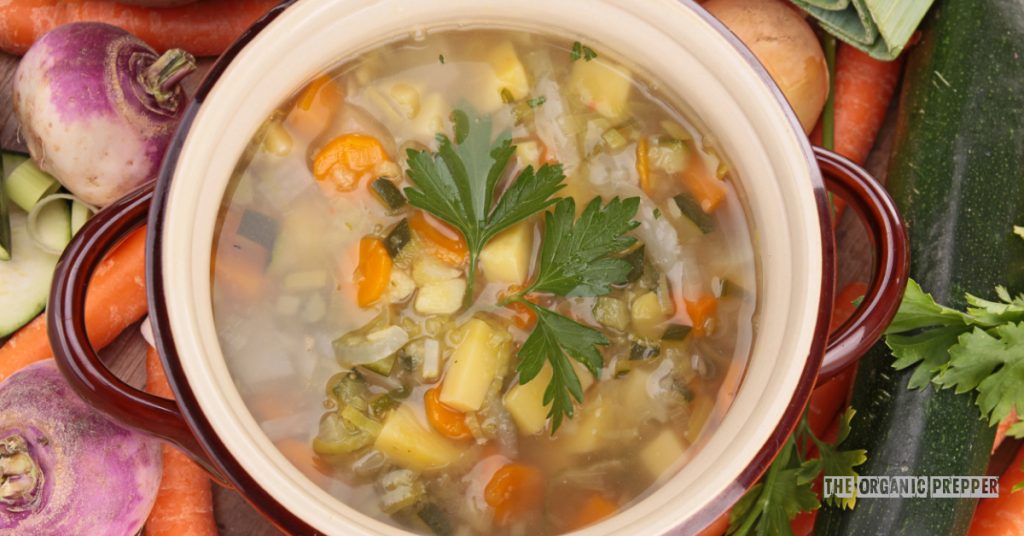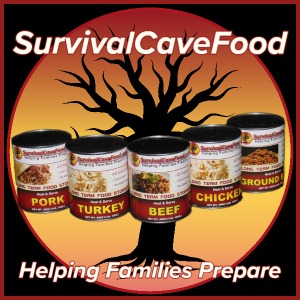If you're new here, you may want to subscribe to my RSS feed. Thanks for visiting!
I keep a pretty well-stocked pantry that has seen its share of difficult moments: vermin, insects, and a roof leak, to name a few. With all the challenges of keeping preps up to date, you want to be a friend of your pantry, not an enemy. This means being more organized than I have been in the past.
I know they say that you can eat canned food years past the Best Before Date, but, in my own experience, I wouldn’t go more than a year out. Daisy has written a great article recently on how to keep your pantry organized and rotate your preps. Check it out to get some great tips!
This article will share a revelation that I had about making soup. In my home, growing up, you always needed a recipe. Now, don’t get me wrong, my mother was a great cook. But one day, I was visiting a friend in the afternoon, and we were both getting a little hungry. “I’ll make some soup,” he said and lifted a big pot onto the stove. I remember thinking, “You can’t just make soup like that!” I then watched him throw in, well, everything except the kitchen sink. The lid literally would not fit on this pot until all the stuff had cooked down a bit. I didn’t know you could just “make soup” like that.
We sat there, having a great chat over coffee, and then around 25 minutes later, he declared the soup was ready. It was delicious! With that experience under my belt, I realized that I, too, could make a soup without a recipe…AND rotate my preps so I never face eating a gross overly old can of whatever again.
Broth Variations
I make my soup in a dutch oven, which holds around a gallon. My broth habits have varied over the years. For a while, I liked having those cubes around. Then, I went purist and made my own veggie broth from my own veggie scraps.
These days, I’m on a bone broth kick. I throw one large tetra pak of bone broth in my dutch oven and then an equal amount of water. This fills it around half way up. I organize my tetra paks on the shelf so that I am always getting the oldest one first.
If I had some broth in the freezer, I would make sure that it was dated and also try to use it within a year. It’s not that it’s going bad in there, but the flavor just won’t be the same.
Protein Variations
When a dear friend dropped off a huge turkey breast as a holiday gift, I had a couple meals from the meat and then used the rest to make soup. If I think my iron is low, I’ll fry up a hamburger patty and throw that in. As I love beans, I will always throw some in, too. Quick-cooking red lentils are a favorite of mine. If anything happens to reduce access to fuel (hmmmm, like an APOCALYPSE!?!), then this little fast-cooking lentil is a good one to get to know.
Starch Variations
Most often, I do a mix of starches. I like to pull out a potato from storage and grate it and throw it in. This gives my soup a delightful stew-like consistency. I do love noodles, so I will also throw in a few spaghetti noodles, breaking them in half before I throw them in.
Veggie Variations
This is where I check all three of my layers of winter vegetable storage to assess if there is anything that needs to be used immediately. I described all three of these layers in more detail in this article. As all layers of vegetables stored at fall harvest are still keeping well, I am selecting based on wanting to create a soup with a lot of nutritional variety. Inevitably, there will be some spoilage. When I went to my cool(er) room storage for a carrot yesterday, one had gone bad, but the others are still sprouting and going strong after several months.
Other Add-Ins
You can do the same thing by rotating your canned goods to add to your soups. You can also use veggies in the fridge that need to be used up.
One Example
I wanted to share how fun and creative this can be. Enjoy while you rotate! Here is a list of the ingredients from the most recent version that I made, along with their pantry status:
- 4 cups Bone Broth plus 4 cups water – rotation system in place
- 1 carrot (layer 2) – one carrot discarded, sawdust re-dampened
- 2 beets (layer 1), – all beets checked for spoilage and rinsed – all OK. The tops were actually sprouting, so I planted them by the window to see if they would grow.
- 1 firm sweet potato (layer 2) – perfect condition, sawdust re-dampened
- 2 onions (cool(er) room) – 10 pound bag for less than $2 – what a deal!
- 3 cloves garlic – regular pantry
- handful dried basil (from garden) – stored in regular pantry
- hot pepper flakes – regular pantry
- 1/2 brick organic tofu cut into cubes – purchased recently
- 1 can mixed beans – rotation check
- 1 cup frozen roasted butternut squash cubes (originally from garden – then cool(er) room for 3.5 months, then roasted last month. I checked the freezer and wanted to use them up, making more space in my tiny freezer for this soup!) *It is great to keep some of these cubes frozen to throw into any soup you make!*
- 6 large leaves of organic kale and stalks – purchased recently; I randomly found the largest bundle of kale I had ever SEEN at a high end grocery store on sale for $1.38. You BET I bought it. 1/3 went into the soup. 1/3 will be used for kale chips and the last of it in a delicious kale omelette. It has been rinsed and is being stored in my fridge wrapped in two damp tea towels. It now looks better than when I bought it!
- 1 celery stalk (layer 1) – kept well hydrated by rinsing regularly, this was in perfect condition after a few weeks
I simmered this for over 30 minutes. I want the onion soft, not crunchy. I had to add a few cups of water to keep the broth level up. I want it to be around 2 inches from the top, so it won’t boil over.
How Much Does It Make?
I came out of this with 10 meals! Adding up the cost of the broth, tofu, beans, and kale, you get less than $6.50. The cost of everything else was negligible or from my garden. I count a serving two cups of soup. I kept enough for two meals in the fridge and froze the rest. This is how I eat all winter, going from one soup to the next, freezing some and overlapping them a bit. Every time I make my soup, it is an opportunity to check the three layers of my winter vegetables and ensure my pantry is properly rotated.
Rotation Soup: A Prepper Pantry’s Best Friend
Keep your preps rotated with this easy freestyle soup. How do you ensure your pantry is rotated? Do you make a soup similar to this or something else? Please tell us in the comments section.
















12 Responses
This so reminds me of my parents when I was growing up. For context. I’m 73. My parents were born in 1913 and 1914. They married during the Depression. Mom always put stuff back and said she was “preparing for the siege”. Daddy rarely came into the kitchen, but when he did, he made what I called “acrobatic soup” because in my child’s mind’s eye I envisioned him taking things and flinging them over his shoulder into the soup pot. He had a special pot that he used and I still have it.
Thanks for the reminder that it is time for me to make “acrobatic soup” again.
This is a great story!
A good idea for keeping nutritious food rotated!
My MIL called this a “fun supper”. Thank you for the wonderful reminder. Guess what is for dinner tonight.
Good article. I do something like this on a regular basis. Mine usually starts w/sauteed garlic and onion then it’s whatever I have. Sometimes it’s mostly canned veggies w/the odd, wilty fresh veggie thrown in, other times it’s odds and ends of small amounts of dried beans that aren’t enough for a six serving recipe. I find that one serving of leftover chili makes a really good base too.
vegetable soup is one of my favorites. when it is done the first time you can add some more dried beans and let them sit overnight to keep the soup going. as i have gotten older i have somewhat lost my taste for meat but i always either put some chicken or beef bouillon cubes in it. we don’t waste nothing from our garden.
keep it warm ( we use a CI pot as it holds heat for a long time) and add to it. dried beans will be ready the next day after soaking overnight in the broth and the soup can be eaten for a long time if kept warm or hot. that’s what the pioneers did, like bone broth. they dumped everything into it, kept it hot and threw nothing away.
dang, now i’m hungry just talking about it!!
I always keep some of those large cans of tomato-vegetable soup – like cheap V-8 – to use as a soup base.
Tetra Pak? Please explain! This sounds like a shelf stable way to process wet food? How do you keep meat broth without refrigeration unless you can it? Never heard of tetra pak!
Hi Gina, Thanks for your interest. A tetra pak is basically a “drinking box.” It is shelf stable for a year or more. However, I buy these; I don’t process them at home. If you want to process broth at home, you would need a pressure canner. Daisy wrote a great article on pressure canning, which you can find here:
https://www.theorganicprepper.com/canning-101-pressure-canning/
I often pressure can bone broth when I’m processing other things. Sometime with a turkey carcass that’s been roasted and pretty well picked clean I’ll break it up and cover it with water and boil two or three hours. Then remove all the tiny boranes while saving all I can of the bits of meat. Then dice in potatoes, carrots, celery, garlic, and most any other cooked or raw veggies I have available. Fill sterile jars put on hot lids and rings and pressure can for 90 minutes for quart jars at 15 lbs pressure. Sometimes I’ll add up to 1/4 cup dry beans or brown lentils. The pressure time will cook them.
This weeks veggies from the community pantry included a few carrots, 2 small zuchinni, an onion and a tomato. That reads like the basis for some soup. I had half of a birthday steak I couldn’t finish tuesday. That will be diced into the pot with the veggies.
Sometimes if canned veggies have been around a long time I’ll make a gumbo or a soup to make room for freshly canned things. My mom did that also. My parents were born in 1904 and 1907. They lived through the Spanish flu, WWI, the Great Depression, WWII and retirement in 1971. That generation were the real survivalists. Even in cities they grew gardens in the backyard, flower beds, and along the sides of sidewalks. They retired to a rural place where they grew garlic, corn, strawberries, and greens to sell to specialty restaurants and at a farmers market. They had enough tree fruits and berries to can and dry fruit for themselves and bring to us each winter when they came to visit.
Today I grow enough to can and dry for us and to share or sell. I have chickens and prior to a visit from a neighbors dogs I had rabbits. I hope to replace the rabbits. I go to help at the community pantry and most of the time come home with milk , meats, breads, and whatever else variety has been donated. I can from that also. I’m always surprised it is mostly the more expensive healthy foods that are most donated. Don’t breads without preservatives and lots of dried fruits or seeds and nuts – sell? Our local farmers donate a lot also.
Love this article. I have this “soup” every day for lunch. I love using my freeze-dried spinach in the soup. I can open a can and use just a small bit. If I had to buy a bag it would go bad before I used it all.
It’s just me and I start with a cup of water and start adding in things. My basic is a Tbs. of dry milk and potato flakes and a tsp of corn startch. Some pepper and other spices and then add in leftover or freeze-dried ingredients. Then add leftover meat of most any kind. Canned or freeze-dried.
Yummy stuff
What a great idea. Thank you